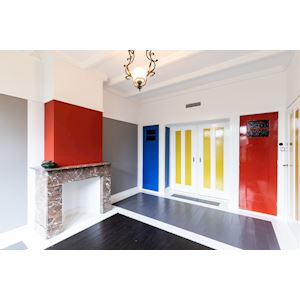
03. Back room
Back room The home was researched not only from the colour angle, but its construction history was also closely studied. The architectural components and structures, such as walls, fireplaces, stairs were examined, as well as the interior design elements such as cupboards, doors, the panelling and the hinges and locks. By comparing Torenstraat 3 with the other houses in the complex, a comprehensive picture emerged of the situation in 1921. The houses have a traditional floor plan with a room layout that was customary at the time. From specifications and building plans it is evident that the houses were fully equipped with electricity, but that both living rooms still had gas lighting: quite old-fashioned with all the electrical lighting in the other rooms. Apparently, gas lighting was still favoured in the living areas. The mantelpieces are executed in soft red-brown and brown-grey marble, a fact that Van Doesburg had to put up with and had to keep in mind for his use of colour in the room. The chair you see in the room was made to a design by Thijs Rinsema. For the decoration of his studio in his home in Drachten, he designed various pieces of furniture in the modernist style. You will find a reconstruction of Thijs Rinsema’s studio in the permanent exhibition of Museum Dr8888. Also take a look at the back garden. Van Doesburg designed different tile surfaces in light grey, dark grey and red. This garden design was implemented for the first time when the home was completed in 2018. Now continue to the kitchen …


Museum Dr8888
Museum Dr8888 is a museum for modern and contemporary art in Drachten, province Friesland. On the basis of a unique collection of works, the museum tells stories that should not be forgotten. In particular, how the international avant-garde came to Drachten in the early twentieth century through Theo van Doesburg and the Rinsema brothers. With a large collection of works from, among others, the art movements Dada and De Stijl, but also expressionism and offshoots of the Hague School, the museum focuses mainly on the time period between the two world wars: the interbellum. Photography Mark Sekuur, Rijksdienst voor het Cultureel Erfgoed/Cultural Heritage Agency of the Netherlands
- Museumplein 2
- Drachten Netherlands
- 0512515647
- www.museumdrachten.nl
